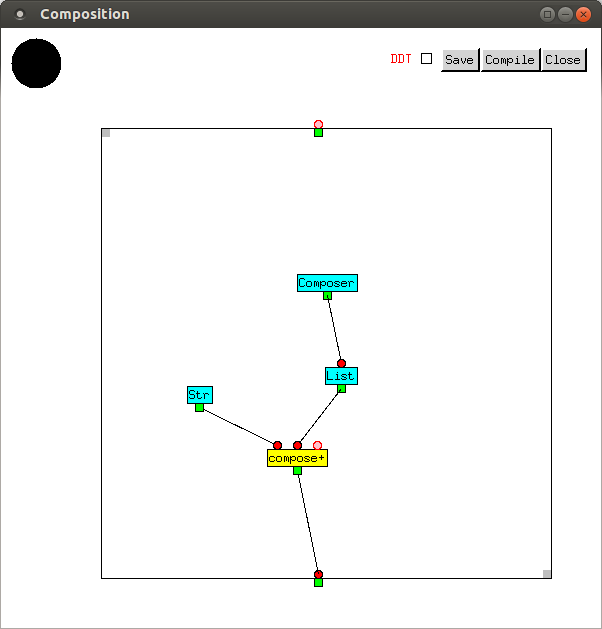Full Metal Jacket is statically typed. As it lacks variables, types are assigned instead to vertex inputs and outputs (and by implication, the edges which connect them). Types are determined in much the same way as they are in Haskell, i.e. by Hindley-Milner type inference, a mechanism similar to unification in Prolog. However, in Full Metal Jacket, type inference occurs at the earliest possible stage: while the program is being edited, i.e. before running the code, and potentially before compiling it. This means the programmer doesn't need to specify any types, and is still prevented from entering an incorrectly typed program. Type inference is explained in detail in Keyboard? How quaint. Visual Dataflow Implemented in Lisp.
The predefined types in Full Metal Jacket include
Int, Real (floating point), Bool
(Boolean), Array, Str (string), Sym
(symbol), Fun (function), List, AList,
Bag, and Channel (for I/O). Types can have
subtypes, e.g. a List of Sym.
No additional elements are necessary for type definitions, as new types are defined using directed graphs (in practice, trees), by composing or extending existing types. The body of the type definition used for type inference is gradually built up as it flows downward through the graph, and constructors and deconstructors are automatically generated.

The attributes of Person are name, date
of birth and sex. These are not defined as separate getter and setter
functions. Instead, the functions unmakePerson and
makePerson are defined. A Person's name
is the first value returned by unmakePerson, their date of birth
is the second value, and their sex is the third value.

Musician extends Person.
A List of Tracks performed by the
Musician is added to all the other attributes of
Person (e.g. name, date of birth
and sex). For example, the Musician Greg Lake played and sang
on a performance of 21st Century Schizoid Man and numerous other
Tracks.
Musician could be defined in Lisp as
(deftype Musician NIL (extend+ Person (List Track)))



A Track is a recording of a performance
of a Composition. It contains an association list
of each Musician and the List of parts
performed by them (each represented by a Sym), and
the length of the performance. For example, the Composition
21st Century Schizoid Man was performed by the Musicians
Robert Fripp on lead guitar, Greg Lake on bass guitar and lead vocals,
Ian McDonald on alto saxophone, and Michael Giles on drums, and has length
7.333333 minutes.
Track could be defined in Lisp as
(deftype Track NIL
(compose+ Composition
(AList Musician (List Sym))
Real))
© Copyright Donald Fisk 2016